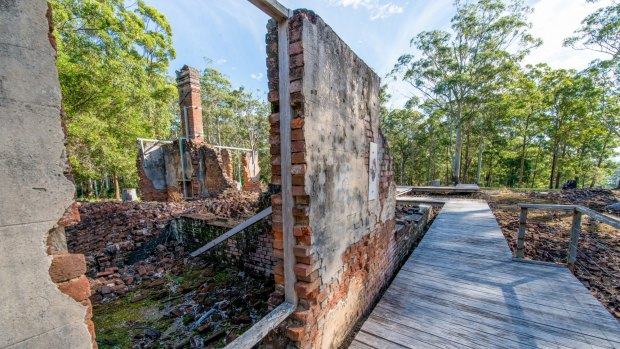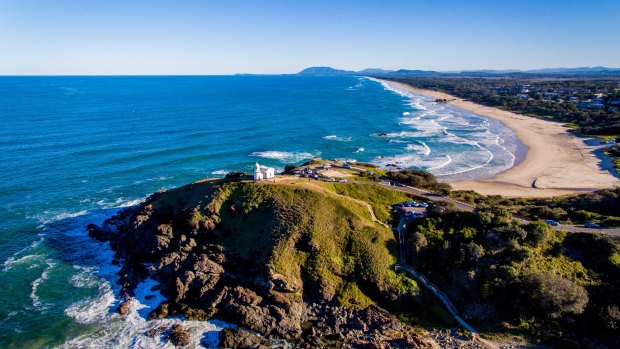This was published 4 years ago
Port Macquarie's Historical Cemetery: Australia's oldest cemetery
By Steve Meacham

Innes Ruins sits within the Lake Innes Nature Reserve. These extensive ruins comprise one of the oldest surviving brick structures in northern NSW.
It's a beautiful late summer afternoon in Port Macquarie, so what better way of enjoying it than taking a cemetery tour? Not any cemetery: this is one of the oldest in Australia - consecrated in 1824. It contains the bodies of 1500 convicts, soldiers and settlers who helped forge the nation.
"Here you'll find the elaborate grave of a Frenchman who claimed to be the illegitimate son of Napoleon Bonaparte," says our guide, Mitch McKay. "Plus another grave of an Irish-born major who survived the battle of Waterloo."
This graveyard also contains the remains of a teenage Jewish convict related to the only known Jewish bushranger in Australian history, as well as members of the Mackellar family which later boasted among their number Dorothea, author of My Country, that began with those familiar words I love a sunburnt country…McKay calls this walking tour of the Historical Cemetery "Grave Tales", and uses the information gleaned from the illegible headstones to convey the complex history of one of Australia's oldest settlements outside the Sydney basin.

Port Macquarie coastal walk. Credit: Lindsay Moller Productions
"Of Australia's state capitals, only Sydney and Hobart are older than 'Port'," says McKay, using the name locals use for the oldest European settlement north of Newcastle.
Port Macquarie is partway through an extended four-year 200th anniversary celebrations of its European discovery. Cook sailed past "Port" at night and Flinders tacked away from it during his 1802-04 circumnavigation. (The country's fourth lighthouse was placed at "Tacking Point" - still a great place to watch the majesty of the ocean).Which left a land explorer, John Oxley, (Governor Lachlan Macquarie's surveyor general) to name it in 1818.
Oxley had been dispatched by Macquarie to discover Australia's mythical inland sea. Instead he found himself following a mighty river he named the Hastings.
"He had to tell Macquarie the bad news that the Hastings had led him to the Pacific," McKay says. "But he had good news too."
Oxley had found a 'safe port' which he had named after his boss, recommending it would make a wonderful penal colony for those convicts who continued a life of crime after they'd been transported.
Previously, these "secondary offenders" had been sent to Newcastle or Hobart. But by 1818, both cities were becoming semi-respectable. A new, more remote penal colony was needed.
In 1821, the first 60 convicts arrived, accompanied by 40 soldiers. Macquarie had been recalled to London, replaced by Sir Ralph Darling who preferred literate criminals to be banished to a place they couldn't communicate with the outside world.
These "specials" built the original colonial town. There were only two hills inside the original town, McKay says. One became Church (St Thomas's, the fifth oldest surviving church in Australia), while the other became State (where the military barracks and Government House stood).
Little remains of those early years. By 1830, Port became open to free settlers and 'ticket of leave' convicts who could turn the town and its lush hinterland into a thriving settlement.McKay's other walking tour, Uncovering Our Past, concentrates on this colonial chapter. It begins at the Glasshouse, Port's superb modern theatre/art gallery, but also the site of original overseers cottages.
If you don't have time for a city tour, just call into the Glasshouse and survey historical objects found during its construction.McKay has a family connection to Port's graves. His wife traces her connection back to the hapless Anne Callaghan, buried at Allman Hill, the town's first cemetery.She died in 1824. Never a convict, she was married to one. And when her husband was sent to the new penal colony, she pleaded with the governor to let her accompany him with their three children. She lasted a few months.
Neither cemetery compares in antiquity with the oldest grave found in Port Macquarie town centre. McKay tells us it has been carbon dated as being at least 1650 years old - a member of the Birpai people whose lives were irredeemably altered when Oxley arrived 200 years ago.
TRIP NOTES
MORE
STAY
Rydges Port Macquarie, I Hay Street, see rydgesportmacquarie.com
TOUR
Port Macquarie Hastings Heritage walking tours, see pmheritage.com.au
EAT
Zebu Bar and Restaurant, see zebu.com.au
Steve Meacham was a guest of Port Macquarie Hastings Heritage walking tours and Port Macquarie Hastings Council.
Sign up for the Traveller Deals newsletter
Get exclusive travel deals delivered straight to your inbox. Sign up now.